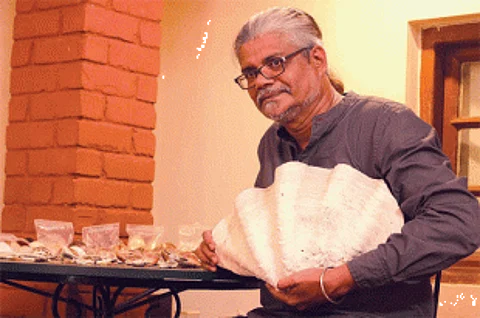

Goa Chitra’s collection includes some of which are rare seashells
or endangered such as the Bull Mouth-Helmet shell (Cassis Rufa), Hoi Bai
(Cypraeidae) and several Conus shells from Australia (Cones). “There are shells
that can kill a human with their poisonous spike. The collection also has
unusual corals and fossils as well as complex corals and shell fossils. The
fossil collection includes thousands of years old fossilised Ammonites, the sea
snail Babylonia, Mussels, Oysters, shells of Spondylus and Strombus, Conchs,
Cowries, Astraea, Turbo, Murex and Scallop-Cockle species,” says Victor. This
taxonomically classified, scientific collection encompasses over 1500 species
of seashells and land and tree snails encompassing more than 55 families
collected from around the world. The shells will be displayed according to
their family, species and origin from across the world.
The beauty of the Goan roots in fishing will be seen through the
eco friendly canoes, nets and tools that were used over a century ago. “Imagine
a fishing canoe that has been carved out of a seed grown mango tree. The museum
will have 37 different fishing boats, different fishing nets before nylon was
introduced. The open fields’ right next to the beach were earlier used by the
fishing community to grow shrubs called Maag which was grown up to a certain
height and then the bark of the tree were used as strings to form the fishing
net called Suun. The next stage of the process to make these nets lasting was
called Ogodd where the bark of the Mati tree was boiled with water and the net.
This net was specifically used to catch kingfish,” says Victor.
Speaking about the need to conserve seashells and their history,
Victor explains the current climatic situation that is deteriorating the life
of corals and fossils, “The concentration of carbon dioxide is increasing and
the oceans are absorbing a quarter of this gas, which is now leading to a lower
pH of seawater and greater acidity. Under this changing chemistry, organisms
are now producing weaker and damaged shells and as time progresses, we will see
less and less of the kinds of shells that Goa Chitra now holds.”
Besides the several uses, marine life is important in
documenting migration all across the world. “Shells can also tell stories of
the migration of people and their trading routes and some historians have even
studied the slave trade using shells. We are also seeing mass mortalities of
coral reefs because of ocean acidification and heat waves with 30 percent of
the Australian Great Barrier Reef’s corals now dead so this makes the
collection even more valuable. Fossils too have gained tremendous importance
because in order to explain the current climate changes, scientists need to
understand the state of the planet in prehistoric times and fossils are a way
to look back into the ocean’s deep history,” he elaborates.
Victor’s fondness for the marine world can be seen in the way he
talks so passionately about the wonders and cultural significance of the simple
shell. Shells had different purposes in daily life. It was used for currency
especially in North America, Africa and the Caribbean, tools and household
objects, sometimes big shells were used as bowls, bathtubs and baptismal fonts,
shells such as oyster shells were used as soil conditioners in horticulture,
musical instruments, ornaments, architectural decoration, arts and crafts.
Though currently, it
is very difficult to import seashells due to the strict Wildlife Protection
Act, Victor has been collecting shells and corals since the 1960s which dates
back over centuries. “I have been collecting sea shells, corals and fossils
from 1960 onwards and this was before the Wildlife Protection Act in 1972. I
even have shells with details of who was the diver and in which year the shell
was discovered with an elaborate description for each piece. All this will be
on display at the museum,” says Victor enthusiastically about Goa’s first
museum of Natural History.
As the museum is set
in Betul, the collection will be temperature controlled. “The museum will
facilitate the climatic conditions of the collection as since the museum is set
up close to the beach, the saline water and air are favourable for the natural
environment of the collection. Another factor that the museum is based in Betul
is that the neighbouring villages of Assolna, Velim and Cuncolim, the major
focus will be on seafarers, many of whom brought home furniture with clams
embedded in them for decorative purposes. Many homes still have their pieces of
furniture which shows the beauty of marine biodiversity,” he explains.
To
conclude, Victor also states a very important reason he is putting up his
private collection of corals and shell fossils on display. “I want to encourage
people to bring out their private collection and display it to the world. There
are many people in Goa who have lovely collection and they are depriving the
researchers and student community of great information but keeping their
collection confined to their homes. I want to create awareness that no matter
what their collection is, it will be a huge benefit for those who want to know
more about it in the future,” says Victor.